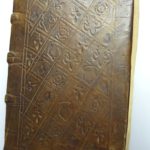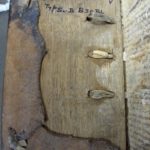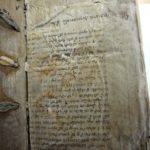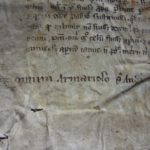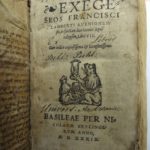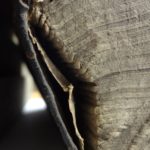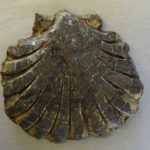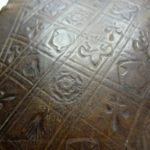52 Weeks of Fantastic Bindings: Week 8
Another early St Andrews binding, with manuscript fragments from St Andrews Cathedral Priory
St Andrews’ copy of Franz Lambert’s “Exegeseos Francisci Lamberti Avenionensis, in sanctam diui Ioannis Apocalypsim, libri VII” (TypSwB.B39BL), printed by Nikolas Brylinger in Basel, 1539, is the only other surviving example of early St Andrean binding. This binding, in many ways, is possibly even more interesting than the two early panel stamped bindings featured in week 6’s post, although they share some similarities.
- Front cover of Franz Lambert’s “Exegeseos,” printed by Nikolas Brylinger in Basel, 1539, and bound in St Andrews in the first half of the 16th century.
- Inside of the front board of TypSwB.B39BL, showing the board and chord structure and the manuscript fly-leaf.
- Front fly-leaf of TypSwB.B39BL, a fragment of a 12th or 13th century Latin manuscript, with a 14th century St Andrean inscription.
- Detail of the St Andrews’ inscription on the front fly-leaf of TypSwB.B39BL, reading: Lib[e]r ex [com]munum armariolo S[ancti] Andr[ee]” (This book is from the community treasure chest of St Andrews).
- Title page of Franz Lambert’s “Exegeseos,” featuring Nikolas Brylinger’s three lion printing device.
- Detail of the 12th or 13th century manuscript leaf fragment, and its conjugate stub, used to wrap the first gathering of TypSwB.B39BL.
- Detail of the concave spine structure and sewn gatherings of TypSwB.B39BL.
- c. 15th century lead pilgrim badge, in the shape of a scallop shell, found on the beach of St. Monans, Fife. From the collection of Fife Council Libraries & Museums, St Andrews Museum.
- Detail of the blind stamped tools found on both boards of TypSwB.B39BL.
TypSwB.B39BL is bound in contemporary calf on wooden boards, both boards have double blind fillets forming a central compartment with blind tooled lozenges in a “diaper pattern”, within which are blind stamps depicting two types of fleurs-de-lys, roses, thistles and scallops. We can deduce that this is a St Andrean binding from a few clues: the use of the “diaper pattern” 30 years after its popularity peaked, the blind-stamped thistles and shells, the similarities in structure to the other known St Andrean bindings and the inclusion of manuscript fragments with provenance from the Augustinian Priory at St Andrews.
The “diaper pattern” was one of the earliest binding styles in the U.K., and was a popular decoration choice in England from c. 1475-1510, later in Scotland, and was slowly replaced by the introduction of roll- and panel-stamps. TypSwB.B39BL is a very crude example of the “diaper patter”, with stamps often found outside of their lozenge-shaped boundaries and with the blind fillets not finished professionally. This crudeness hints at a non-professional binding, and something that was done provincially where a limited number of tools were available. Some of the tools used inside the lozenge compartments are very curious: the large thistle stamp is an obvious hint to Scottish provenance; however the scallop shell is more of a puzzle. The scallop shell was traditionally the symbol of a pilgrim who had completed the Way of St. James (El Camino de Santiago) to the Cathedral of Santiago de Compestela, but later came to symbolize pilgrims in general. Lead pilgrim badges in the shape of scallops (such as the one pictured above) have been found off the coast of the Isle of May and St Andrews, both early pilgrimage sites, and so we can assume that the scallop tool on this book refers to the St Andrews pilgrimage.
Although much smaller in size, TypSwB.B39BL’s structure is very similar to the two other early St Andrean bindings mentioned above: all three of these books have similar material used in the chording and boards. Also, all three of these items’ spines have not been hammered professionally, creating a concave spine structure (see photo above) and convex fore-edges.
Lastly, and most excitingly, fragments of a 12th or 13th century Latin manuscript have been used as protective fly-leaves in this binding. The front fly-leaf fragment bears a 14th century inscription at the foot of the manuscript (top of the fly-leaf) which reads: “Lib[e]r ex [com]munum armariolo S[ancti] Andr[ee]” (This book is from the community treasure chest of St Andrews). Both fragments are in the same hand and from the same work and were used as protective wrappers around the first and last gatherings. This manuscript fragment (also listed in the St Andrews University Manuscript Catalogue, MS 38831) is one of two manuscripts still in St Andrews’ collections known to have been produced in the Augustinian Cathedral Priory at St Andrews (the rest can be found at the Herzog August Bibliothek, Wolfenbüttel).
–DG
